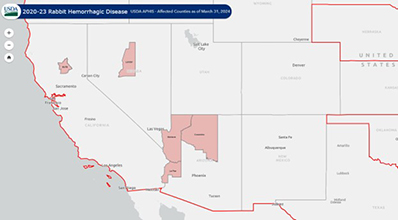
Rabbit Hemorrhagic Disease (RHD)
Movement Restrictions for Rabbits and Hares Entering California
Due to the ongoing outbreak of Rabbit Hemorrhagic Disease (RHD) in the U.S., California has implemented a statewide quarantine with movement restrictions for rabbits and hares entering California.
No rabbits, hares, or their products (meat, pelts, hides, carcasses, etc.) and equipment or other items or associated materials may enter California from states or countries where Rabbit Hemorrhagic Disease (RHD) has been diagnosed in the prior 12 months unless they meet the following requirements.
-
All live rabbits and hares require a Certificate of Veterinary Inspection, and must be inspected by an accredited veterinarian within 72 hours prior to shipping to California. The CVI must include a statement by an accredited veterinarian certifying that:
- All rabbits and hares in the shipment have been examined for and found free of communicable diseases, and
- All rabbits and hares have originated from a single premises that has no signs of a communicable disease, and
- There have been no movements of rabbits and hares onto the premises over the prior 30-days, and
- The animals have had no contact with wild rabbits or hares in the past 30 days.
- No rabbits and hares or rabbit and hare products (meat, pelts, hides, carcasses, etc.) and equipment or other items or associated materials may enter California from a premises known to be affected with RHD.
Rabbit hemorrhagic disease is a serious and extremely contagious viral disease of domesticated and wild rabbits. Morbidity and mortality rates are high in unvaccinated animals; on some farms, most or all the rabbits may die. This disease has also caused dramatic declines in some wild rabbit populations, particularly when it was first introduced.
RHD virus (RHDV) was first seen in China in 1984, and since there have been confirmed cases in 40 countries, including in Europe, the Mediterranean, Africa, Asia, Israel, the UK, Mexico, the US, Canada, Australia and New Zealand. RHDV2, a second strain, emerged in France in 2010, and quickly spread in Europe and the Mediterranean, and has replaced the original strain in many countries. In 2015, RHDV2 was first detected in Australia, and it spread coast-to-coast in the rabbit population in 18 months and became the dominant strain replacing RHDV1.
Symptoms may include:
- Loss of appetite
- Lethargy
- High fever
- Seizures
- Bleeding from nose, mouth, or rectum
- Difficulty breathing
- Sudden death*
*Rabbits may die without showing any symptoms at all.
Field Contacts
(209) 491-9350
(909) 947-5932
(530) 225-2140
(559) 685-3500
CA Dept. of Fish & Wildlife - Wildlife Investigations Lab
(916) 358-2790
Resources
Contact Us
California Department of Food and Agriculture
Animal Health and Food Safety Services,
Animal Health Branch
1220 N Street
Sacramento, California 95814


